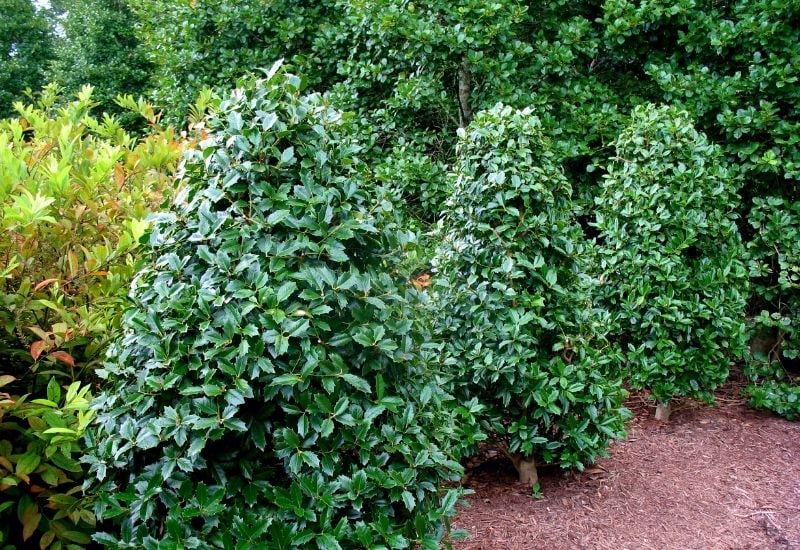
Picture this: one one side of the road, a small garden with tall and narrow shrubs, foliage, texture, even flowers, on the other side, a tall brick wall, or a wood fence. Both provide privacy, both protect your family and guests from prying eyes.
But one will look like a barrier, a barren and soulless construction. The other will look like a green place, changing with the seasons, soft, colorful, and even full of life!
Fastigiate shrubs with their erect silhouette can create a stunning decorative highlight and punctuation point when you plant them between your home and driveway, along your fence line, or in a row.
Whether their foliage is deciduous or evergreen, shrub with a columnar, conical or pyramidal shape, can act as privacy screens, form a narrow hedge in groups despite the lack of space.
There is a surprisingly wide selection shrubs with narrow, slender growth habit which requires very little pruning to maintain a narrow habit, making them ideal for screening and hedging in smaller urban or suburban gardens.
Whether you’re looking to block an unwanted views or drawing the eye towards a specific feature in your garden or simply want a decorative privacy hedge here are 15 tall and narrow shrubs for screening particularly suitable for small gardens where space is tight.
1. ‘Compressa’ Common Juniper (Juniperus communis ‘Compressa’)
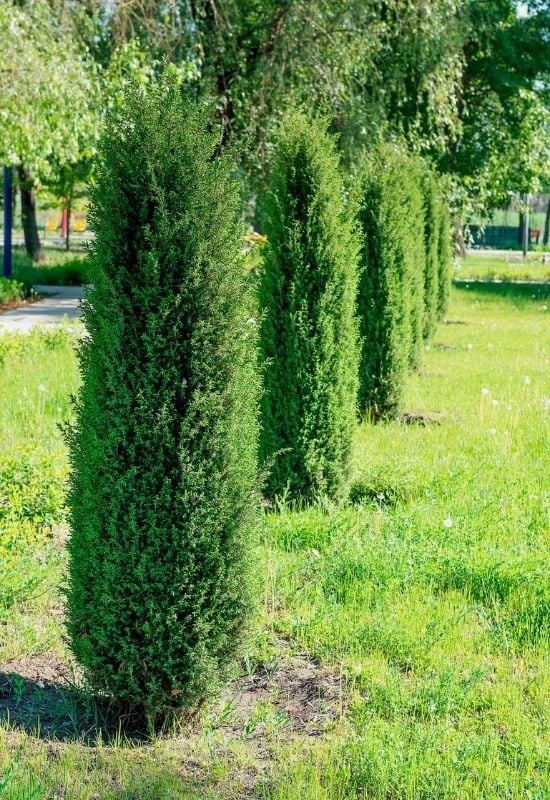
For a small long, columnar and very dense screening shrub, ‘Compressa’ common juniper is an exceptional choice.
The blue green, aquamarine foliage of tightly packed needles will give accent to any garden, and in winter, it will also take on copper bronze shades.
This evergreen conifer is both low maintenance and very strong: cold hardy as well ad drought resistant, it is ideal for urban and suburban gardens if you have little time to dedicate to your yard. It is not particularly tall, but it is small enough to grow in containers, so, you can get it to reach eye level very easily.
‘Compressa’ common juniper will bring unusual colors to your garden, you can also grow it as a specimen plant, to give a vertical dimension to your design, and you will also boast a winner of the prestigious Award of Garden Merit by the Royal Horticultural Society among your collection!
2. ‘Sky Pencil’ Japanese Holly (Ilex crenata ‘Sky Pencil’)
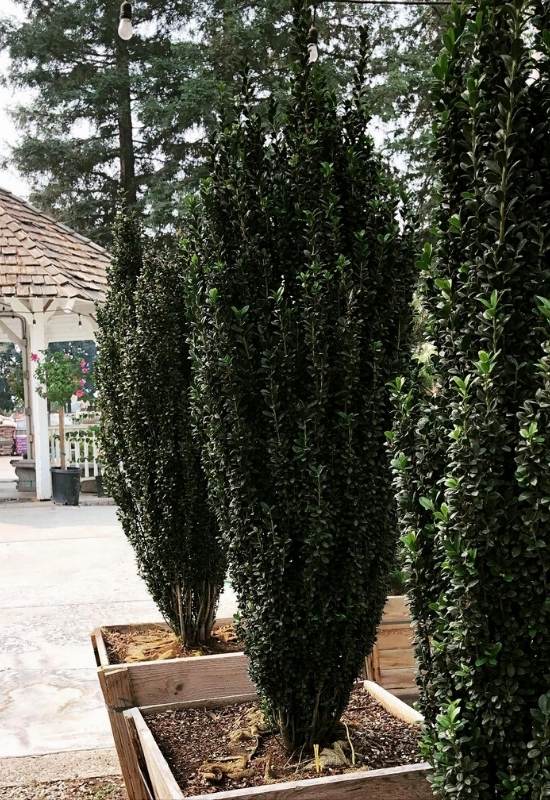
Growing to 10 feet tall (3.0 meters) but only to a maximum of 3 in spread (90 cm), the aptly named ‘Sky Pencil’ Japanese holly is as columnar as a shrub can get!
The evergreen foliage is dark green and convex, creating interesting light games, and it grows on upright branches that grow parallel and look like they want to reach the blue sky.
It will also add small white flowers in spring, which will give way to black fruits later in the season, but you need male and female specimens for this to happen. You can also train it to become a small tree if you wish.
‘Small Pencil’ Japanese holly is one of the most vertical bushes you can grow in your garden; it is not as dense as other plants, but it is enough to screen your private space from passers by and curious neighbors.
3. ‘Green Spire’ Japanese Euonymus (Euonymus japonicus ‘Green Spire’)
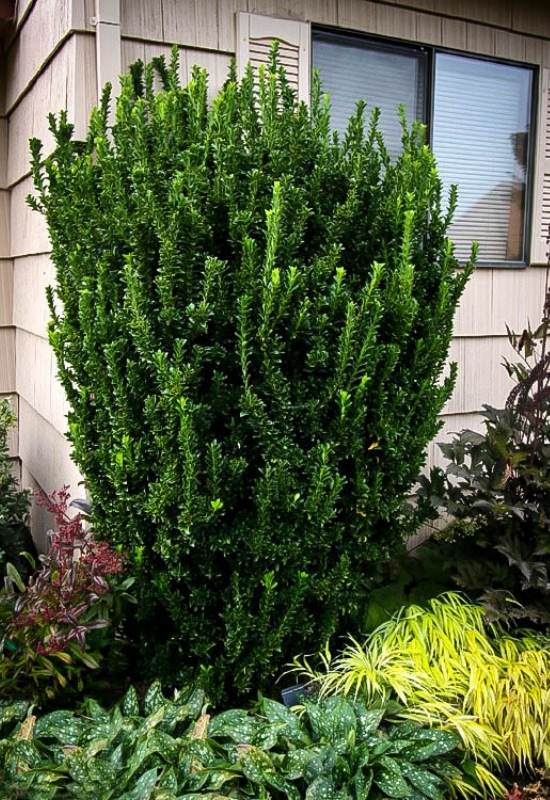
Fast growing and fully screening ‘Green Spire’ Japanese euonymus will reach up to 8 feet tall (2.4 meters) but it will not spread over 2 feet (60 cm).
And in this small space you will get beautiful dark green, glossy and evergreen foliage; each leaf is concave, like a spoon, and it is gently serrated at the margins.
They will come on branches that grow upwards, and they will form a thick canopy that completely cuts off any view; this makes it ideal for urban and suburban hedges, thanks to its columnar habit and impenetrable foliage, but also because it is a very reliable and low maintenance plant.
‘Green Spire’ Japanese euonymus will look great in many garden styles, including Asian, Mediterranean, urban, gravel and any informal design; however, if you fancy pruning it regularly, it will also adapt to formal settings. And this is a rare quality.
4. ‘Orange Rocket’ Barberry (Barberis thunbergii ‘Orange Rocket’)
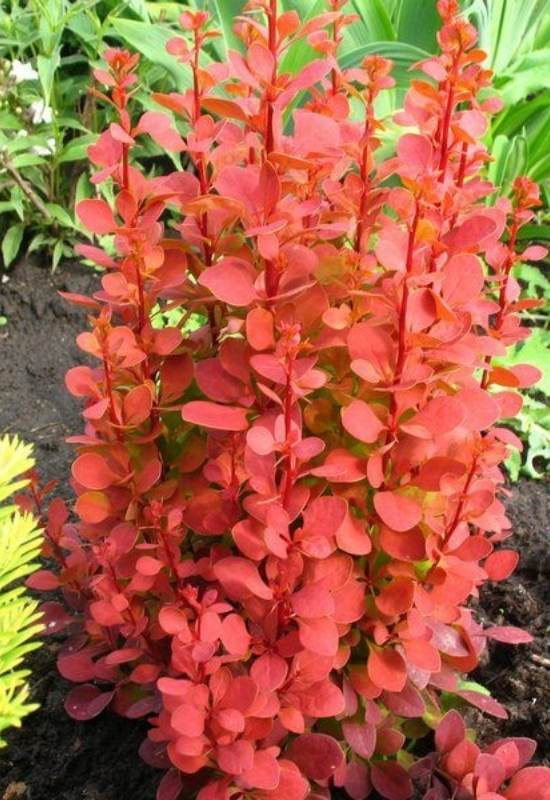
Compact and upright, ‘Orange Rocket’ barberry is also a an explosion of warmth and color! In fact, the coral to orange red foliage can be a focal point in any small garden.
The round deciduous leaves grow in vertical branches and form a dense barrier to protect your privacy.
The shades will change in fall, when they turn towards russet tints. In spring, small, pale yellow and scented flowers will blossom, and these will in turn become crimson red berries later in the fall, attracting birds to your garden. In winter, you will be left with red spiny stems; they won’t fully block the view, but they will certainly deter any intruder, and they still look attractive and dense.
Surely the color of foliage is the main asset of ‘Orange Rocket’ barberry as a tall shrub for screening, you can bring lots vibrant vitality to your small garden with a low maintenance and strong flaming shrub.
5. ‘Fine Line’ Buckthorn (Rhamnus frangula ‘Fine Line’)
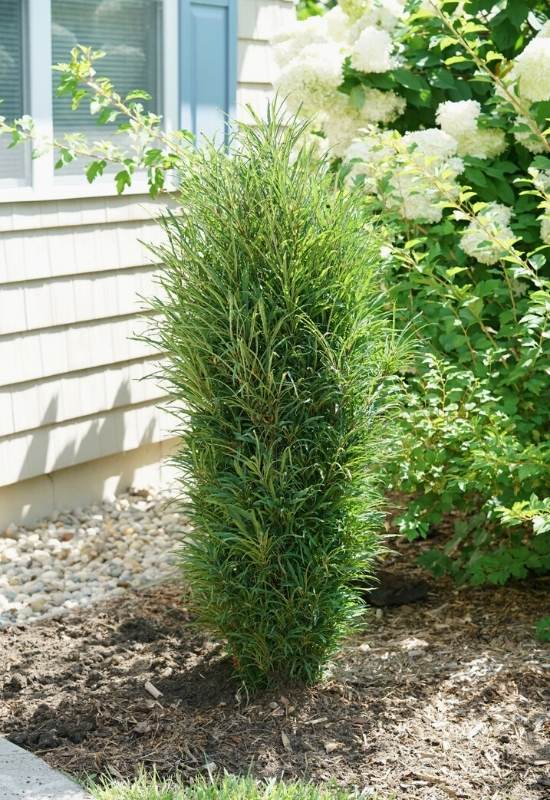
Fast growing ‘Fine Line’ buckthorn is ideal in containers, to block views from windows, or to create privacy as foundation planting. Its feathery foliage is very elegant, with thin and long mid green leaves that grow on upright branches giving you very elegant and refined texture, and a dense screen from spring to late fall. It is also ideal for cold regions, including most of Canada, thanks to its great hardiness.
‘Fine Line’ buckthorn has a very discreet and elegant presence; it is not showy but gentle, and for this reason it will work well in most situations; you can plant it with other shrubs, or in pots; you can have it for foliage in tall borders, or mix it in in hedges, as long as your design is informal.
6. ‘Delta Moonlight’ Crape Myrtle (Lagerstroemia indica ‘Delta Moonlight’)
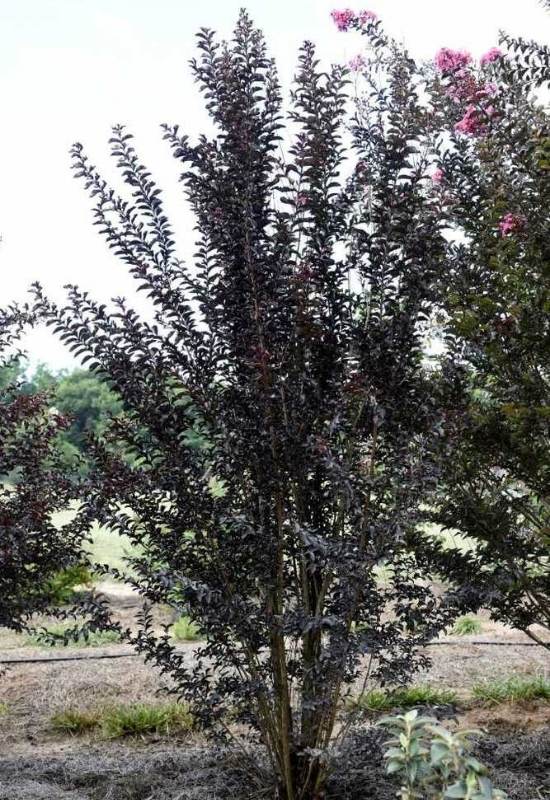
For slightly larger gardens, the stunning effect of tall and fairly narrow ‘Delta Moonlight’ crape myrtle is a real decorative asset for your privacy. Growing fast to up to 12 feet (3.6 meters), it will keep unwanted eyes off your property with a wall of uniquely colored foliage.
The thick leaves are of the darkest shade of burgundy you can imagine, almost black, in fact. Curved and pointed, they will form a thick canopy from spring to frost, and they will host large clusters of flowers late in the season.
The blooms are frilled, tightly packed at the tips of branches and white with a gentle purple blush hanging on pink petioles. The contrast is really striking and eye catching, for a real show stopper maybe at the back of your green space.
‘Delta Moonlight’ crape myrtle is good for screens, hedges and windscreens, but also for foundation planting. If you want to make a bold statement, this shrub may be the one for you.
7. ‘Purple Pillar’ Rose of Sharon (Hibiscus syriacus ‘Purple Pillar’)
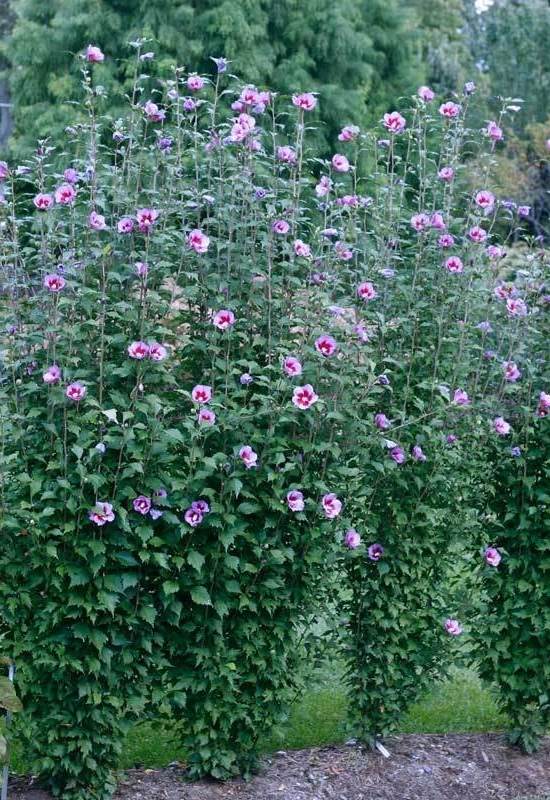
A shrub for screening with showy blooms is ‘Purple Pillar’ rose of Sharon, an unusual cultivar of rose of Sharon that grows very tall and keeps an narrow habit.
In fact, it will reach up to 16 feet in height (4.8 meters) but it will only take up 3 feet (90 cm) of your space in spread. Packed in this tiny area, you will get beautiful, large bright pink purple flowers with a dark and rayed wine red center, and quite a few of them!
The foliage is typically serrated, mid to dark green, and with an interesting texture, growing in upright branches and forming a thick and lush pillar of dense leaves. You can also turn it into a tree, but it is far more common in rows to form green walls that start from low down near the soil and block off curious eyes.
‘Purple Pillar’ rose of Sharon is ideal if you want to have exotic looking blooms even in fairly cold regions, and it can block views even from higher vantage points, like the windows of nearby homes.
8. Blue Bamboo (Bambusa chungii ‘Barbelletta’)
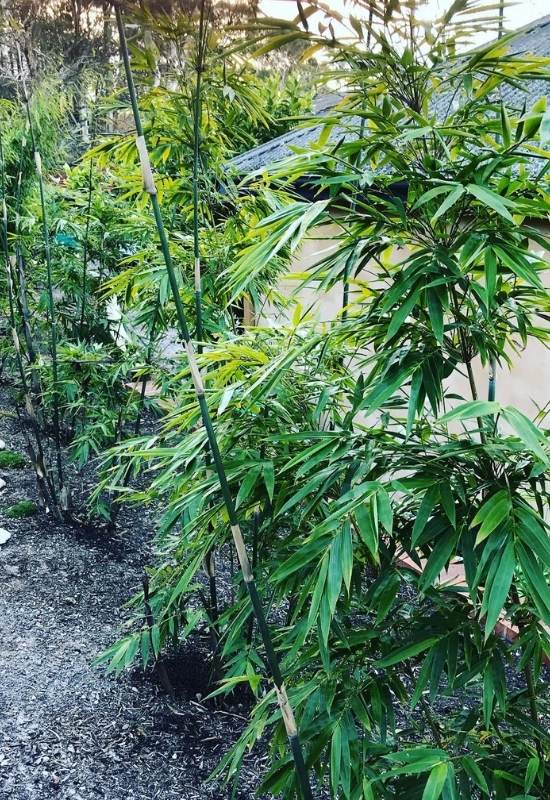
Blue bamboo will grow very tall, up to 25 feet in fact (7.5 meters) and you can easily control the width and spread of the clumps, forming shrubs of the size you need for your privacy and available space.
But this variety also adds a very interesting feature to your garden: the stems are born green, but as they mature, they turn to a striking blue violet silver color, with an icing effect to them too.
They will grow thick, forming real barriers for onlookers, and the bright green foliage tops the whole effect off very beautifully. It is fast growing and fairly low maintenance as well; your main task will be watering it and controlling new shoots.
Though not technically a shrub, blue bamboo will give you the same effect and with the added oriental touch, and the opportunity to “cut it to size” to suit your space and the shape of your garden.
9. ‘Golden Oakland’ Holly (Ilex hybrid ‘Magden’ PP30451)
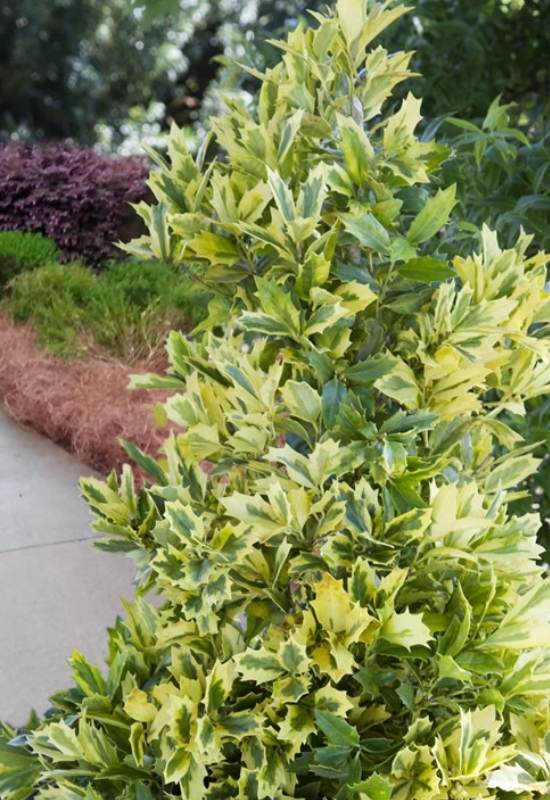
‘Golden Oakland’ holly is an evergreen shrub with a pyramidal habit, with a pointed tip and dense screening foliage.
The leaves are variegated cream to golden yellow and green, giving you a wonderful colorful display, they are typically spiked and quite glossy indeed as well.
This variety offers you interest all year round, but it is also low maintenance and vigorous. It is ideal for foundation planting, but it will work well in hedges and screens as well, in urban, suburban and other types of both formal and informal gardens.
‘Golden Oakland’ holly can spread a bit, but like all plants of this genus, is tolerates pruning very well; for this reason, you can shape it as you wish, and this makes it suitable to formal gardens.
However, the best use of this evergreen shrub is to preserve its natural pyramidal shape, and maybe just keep it narrow if you wish.
10. ‘Golden Cone’ Common Juniper (Juniperus communis ‘Golden Cone’)
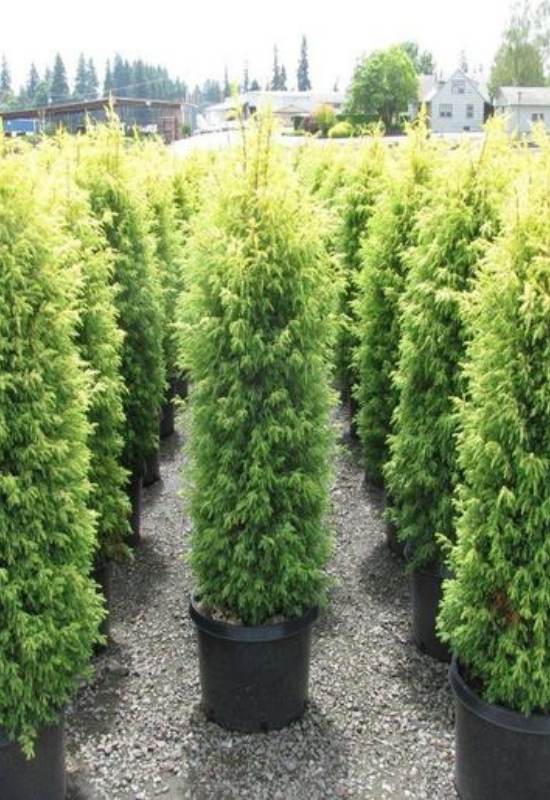
As the name suggests, ‘Golden Cone’ common juniper is an evergreen conifer shrub with a conical shape, tall and narrow, and it will work well to screen your small garden or to give it some interesting structure.
Or color, because the foliage is bright golden in spring, and then it keeps its brightness but slowly fades to a more green tint as the season progresses.
And texture as well, because the soft needles form a cushion like, dense and delicate mass. To heighten it, you can plant it in containers, and this way it will just about top any head that walks past your garden, keeping it private for you, your family and your guests only.
Low maintenance and very reliable, ‘Golden Cone’ common juniper will equally suit borders, hedges and foundation planting, but it is also an excellent accent plant, thanks to its unusual color and vertical but orderly habit. And it is very cold hardy too!
11. ‘Graham Blandy’ Boxwood (Boxus semprevirens ‘Graham Blandy’)
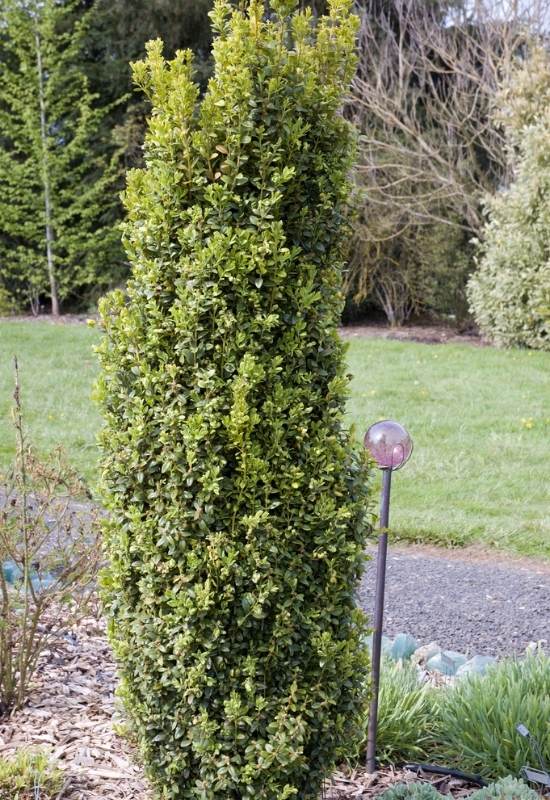
‘Graham Blandy’ is the variety of boxwood you need if you want an evergreen that grows in height and little in spread to screen small gardens.
In fact, it can tower 15 feet in the sky (4.5 meters), but it will never grow more than 2 feet, or only 60 cm in width. With a perfect and elegant conical shape and dense green foliage made up of myriad little oval leaves, it will form a perfect shield if planted in rows.
Easy to grow, it will also produce small, cream, yellow or green flowers with a nice fragrance, though it is mainly loved for its dense and sturdy green canopy. It is also a winner of the Award of Garden Merit by the Royal Horticultural Society.
Like all other varieties of boxwood, ‘Graham Blandy’ is very prune friendly, to the point that it is suitable for topiaries. For this reason, you can also grow it in a very formal garden, and this is quite a special quality in shrubs.
12. ‘Illuminati Tower’ Mock Orange (Philadelphus coronarius ‘Illuminati Tower’)
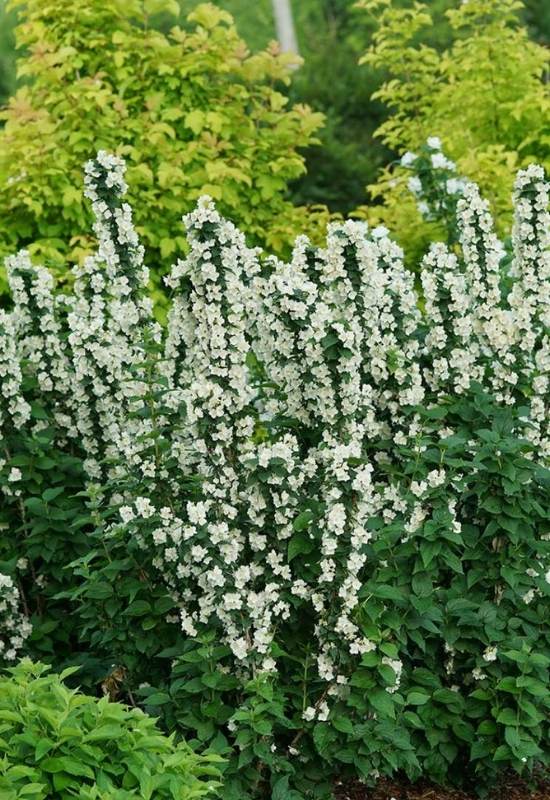
The ‘Illuminati Tower’ cultivar of mock orange is peculiar because it is tall and narrow, unlike other that spread a lot. In a container, it will reach the right height you need to keep unwanted eyes off your property, thanks to its dense, mid to dark green foliage.
But this deciduous shrub has much more to offer to your small garden… It will literally fill with a sea of candid, round, snow white flowers with a cream center and a strong, fresh fragrance.
It will also attract many butterflies and pollinators to your green space, adding a fluttering display of colors and life.
‘Iluminati Tower’ is perfect for small informal garden solutions, like cottage gardens, English country gardens but also urban and suburban ones, as long as you like the fresh look and aroma of this traditional looking shrub.
13. ‘Pinpoint’ Blue False Cypress (Chamaecyparis lawsoniana ‘Pinpoint’)
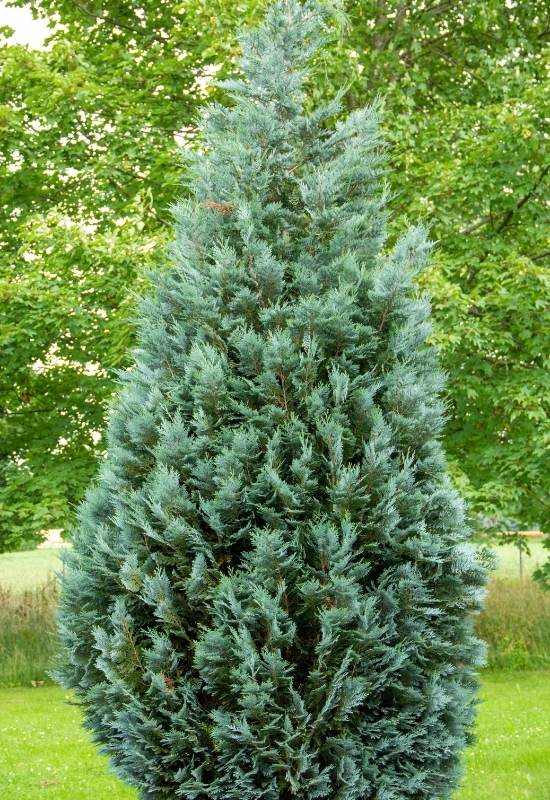
‘Pinpoint’ blue false cypress will screen your garden’s privacy with its dense foliage, and tall but narrow needle shape. In fact, with its slender conical habit and impenetrable bluish green leaves, this shrub can reach 20 feet tall (6.0 meters) but it will only take up a maximum of 5 feet (1.5 meters) of your soil.
Like all conifers, it is also evergreen, which means that it will protect you and your family even in cold winters, when most other shrubs have bare branches.
It is low maintenance and very architectural, so you can easily grow it even if you don’t have much time to do your gardening.
‘Pinpoint’ will look great in urban, suburban and gravel gardens, but not only. You can grow it in rows for a tall hedge or windscreen, but also as a specimen plant it is quite valuable, thanks to its particular shape.
14. ‘Laced Up’ Elderberry (Sambucus nigra ‘Laced Up’)
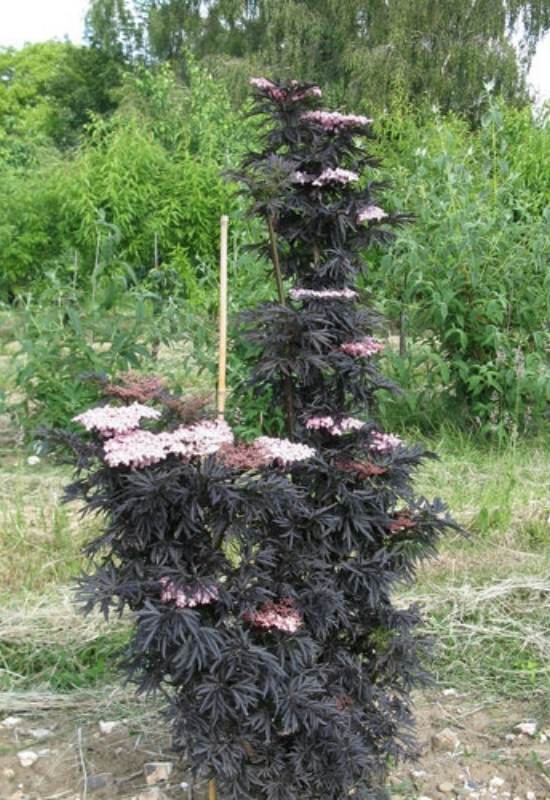
Lace yourself up for an astounding dark beauty, tall, slim and perfect for privacy: ‘Lace Up’ elderberry! The deeply cut and lobed leaves of thus shrub are so dark that they are practically black…
In fact it is one of the darkest foliage colors you will ever see. They form a lace like clump with amazing texture as well as chromatic value.
The blooms contrast them so well in color but keep the thin texture theme… They are white and pink, and collected in wide and flat umbels at the end of branches.
Unlike other varieties, this cultivar has a conical or columnar habit, which is what you can grow well in small gardens, but with a very Gothic twist!
‘Lace Up’ is a new cultivar with a striking beauty; you can even have it in a modern inspired garden, but it will suit any informal designs, both as a specimen plant or in groups, in hedges and screens or even tall borders.
15. ‘Fastigata Aurea’ Irish Yew (Taxus baccata ‘Fastigata Aurea’)
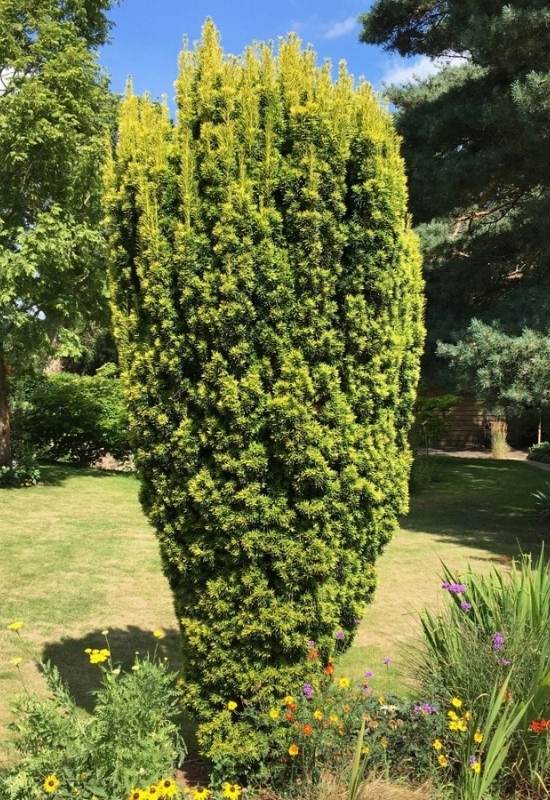
For a golden towering shrub in medium or large gardens that can block views even from high up windows, ‘Fastigata Aurea’ Irish Yew is the ideal choice.
Growing to a whopping 30 feet (9.0 meters) but never stretching over 8 feet in width (2.4 meters) this columnar evergreen will fill your days with a thick golden green light, sometimes lime, in what looks like a thinly decorated natural pillar – all year round.
It will take time to reach full maturity, but in the meantime you will also enjoy its coral red cones that look like little cups, or even Christmas decorations.
Yew is a favorite plant for screens and hedges thanks to its adaptability, but ‘Fastigata Aurea’ stands out for the color of its foliage and unique vertical accent and strength; easy to grow and with few demands, it is a giant of privacy and beauty as well.
Tall, Skinny and Beautiful Shrubs to Block Prying Eyes
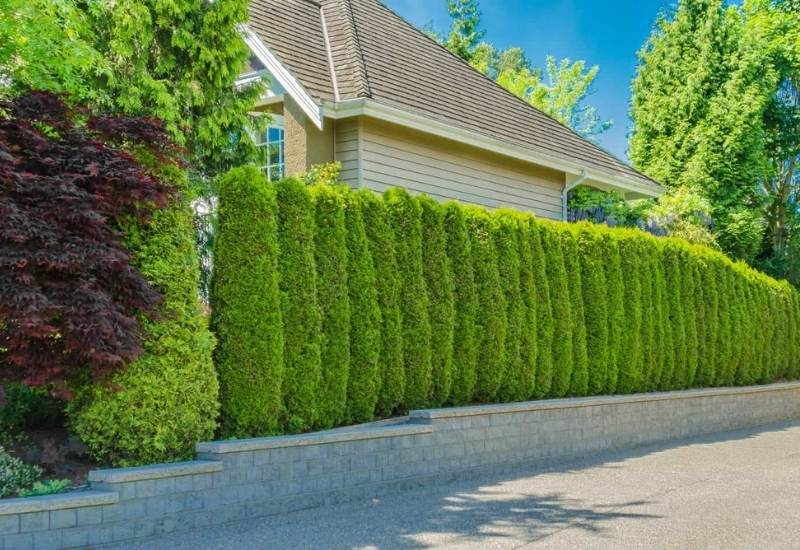
Some of the shrubs you have seen are better for very small gardens, others will require slightly larger spaces; some will bloom and others will keep their leaves on all year round; just pick the best for your situation and forget about people peeking into your property and private life.

Written By
Margie Fetchik
Margie and Arkansas native has an extensive background in gardening and landscaping. For the last 40 years, Margie has called the Colorado Rocky Mountains her home. Here she and her husband of 36 years raised three kids and owned a successful landscaping company. Margie has a CSU Master Gardener certification. She specialized in garden design & installation, perennial gardens, turf grasses & weeds, flower containers, and the overall maintenance of allHOA, commercial and residential accounts. She and her husband now reside in Denver and are excited about the new experiences’ city life holds.

I live in Toronto Ont.
I am planting trees in a rectangular space width of 34 inches
I want to grow a fast growing tree hedge to gain privacy from my very close neighbor.
It should be able to grow 10 ft in mostly full sun sandy soil
I’m thinking of Taylor juniper , moonglow juniper, junior green giant
What do you think is best? Don with thanks
Hi Don,
If you’re looking for a fast-growing tree hedge to gain privacy from your neighbor, the three options you mentioned are all good choices. However, based on the information you provided, I would recommend the Green Giant Arborvitae (Thuja plicata ‘Green Giant’) as the best option.
Don–
I live about 150 miles from Taylor, Nebraska, where the Taylor juniper was discovered. We see a lot of them in landscapes in this area, and they are certainly a great plant. Their width, however, can reach 5′, so I would suggest they will be too wide for your location. Definitely scout around your landscape for another place to use one or two or three of these great junipers!
Looking for something tall and narrow with color to go on the end of a sandstone house that gets really hot…..considering Helmand Pillar Barberry… Front of house that faces South In Wichita, Ks.
The Helmond Pillar Barberry could be a good choice for adding color and height to the end of your sandstone house that gets really hot. This plant is known for its upright, narrow growth habit and reddish-purple foliage that can add visual interest to your landscape.
However, it’s important to note that barberries can be invasive in some areas, so it’s a good idea to check with your local nursery or extension office to make sure that it’s not a problem plant in your region. In addition, barberries have thorns, which can be a consideration if you have children or pets that may be playing near the plant. Other options to consider could be ornamental grasses, such as feather reed grass (Calamagrostis acutiflora), which have tall, narrow growth habits and can thrive in hot, sunny conditions. Another possibility is the purple smoke bush (Cotinus coggygria), which has a columnar growth habit and deep purple foliage that can provide striking color.
Hi Margie, another Arkansan here! I’m looking for something to plant between houses…at least 6’ tall but as narrow as possible for almost full shade. Is there any such evergreen or am I limited to vines? Thanks!
When it comes to planting between houses, there are a few evergreen options that could work well for almost full shade. One option is the Hicks Yew, which can grow up to 20 feet tall but can also be easily pruned to fit the space. Another option is the Dwarf Alberta Spruce, which stays narrow and compact, but may not grow as tall as you are hoping for.
Hello, I live in East TN. Looking for a privacy boundary and would like to be a combination of tall shrubs and trees as to not look so man made. What a good combination that will grow well together and give depth and not make it look like I just bought one tree in a row to block out my neighbors.
Let’s mix things up and have some fun with a combination of tall shrubs and trees that’ll give depth and a more natural look.
Rockin’ Eastern Red Cedar: These evergreen trees are like the rockstars of privacy screens. They grow tall, super dense, and add a touch of wildness to your yard. Plus, those feathery leaves and berries are the perfect fashion statement!
Awesome American Holly: These bad boys are evergreen too, and they know how to bring the glam. With their shiny green leaves and vibrant red berries, they’ll make your boundary pop. You can shape ’em into a tall shrub or let ’em grow into a fancy little tree. It’s your call!
Viburnum Vibes: Check out the Arrowwood Viburnum! It’s a deciduous shrub that grows tall, reaching for the sky at 6-10 feet. Springtime brings gorgeous white flowers, and in late summer, you’ll be treated to cool blue-black berries that’ll make your feathered friends go crazy.
Eastern Redbud, the Showstopper: Picture this: your privacy boundary decked out with a tree that puts on a dazzling pink or purple flower show in early spring. That’s the Eastern Redbud for you! Plus, its heart-shaped leaves make it a real heartthrob. It’s like a natural backdrop for your backyard adventures.
Serviceberry, the All-Star: This tree or shrub is a true MVP. It’s got it all—pretty white flowers in spring, yummy berries for you to enjoy, and stunning fall foliage. Talk about a triple threat! You can keep it at the height you want by giving it a little trim.
Fragrant Sumac, the Wild Child: If you’re up for something more laid-back and wild, the Fragrant Sumac is your go-to shrub. It’s deciduous, meaning it loses its leaves in winter, but boy, does it make up for it with its fragrant leaves, eye-catching fall colors, and clusters of red berries. It’s like the life of the party in your privacy boundary!
Mix and match these cool plants in a way that suits your style, and you’ll have a privacy boundary that’s anything but boring. Don’t forget to give them enough room to grow and thrive. And hey, if you want some expert advice tailored to East TN, reach out to local nurseries or landscaping pros—they’ll be your gardening superheroes!
Have a blast creating your awesome, natural-looking privacy boundary!
Recommendations for a north side driveway, between homes. Need privacy for a bathroom window that looks into the neighbor’s kitchen! Am in Denver Colorado and the north side of the house seems to have it’s own microclimate in the winter, the snow and ice are eternal on that side!
Can you control the height of the laced-up elderberry?
To control the height of a laced-up elderberry:
Prune for shape: In early spring, before new growth emerges, selectively prune the branches to shape the elderberry to your desired height. Remove any dead, damaged, or crossing branches. Trim back long or unruly branches to maintain a more compact form.
Regular pruning: Throughout the growing season, you can continue to prune back any excessive growth to keep the plant at the desired height. Pruning can be done after flowering or during dormant periods.
Training: As the elderberry grows, you can also train it by tying or guiding the branches to grow in a more upright direction. Use plant ties or soft string to gently secure the branches to a support structure, such as a trellis or stake. Regularly check and adjust the ties as needed to ensure proper growth and support.
By combining selective pruning and training, you can effectively manage the height and form of a laced-up elderberry. However, it’s essential to keep in mind that the plant will still have some natural growth tendencies, and it may not be possible to restrict its height completely.
Hi there! I live 2 miles from Lake Ontario in Rochester, NY, zone 6b. I have a blank slate of a suburban, wooden fenced in back yard. I’d love some privacy trees, maybe maximum 12-15 feet arborvitae or small trees. Originally thinking a wall of arborvitae but now maybe some variety. Was thinking of a flowering crabapple in the far right corner. I basically love everything but don’t want it to look too crowded. Thank you in advance, love your gardening tips.
Thanks for this article! We have a space about 3 ft wide and maybe 10 ft long next to our patio, and directly next to our neighbors’ property… right now it features a rather ugly, cob-jobbed “privacy fence” that my husband made from pallet boards. I tried growing plants there but the only thing that thrives is Bishop’s Weed and Pachysandra, neither of which assist with privacy. I’d like to do a “natural fence” instead but I’m concerned about the roots damaging our concrete patio. Any suggestions? We live in Buffalo NY area, zone 6a. Thanks in advance!
Thanks a bunch for reading the article and reaching out with your question. I totally understand your desire to improve the look and privacy of that space next to your patio. A “natural fence” sounds like a fantastic idea!
Considering your concern about the roots damaging your concrete patio, there are a few options you could explore. One approach is to choose plants with non-invasive root systems that are less likely to cause damage. Some great choices for your zone 6a in Buffalo, NY could be:
Arborvitae (Thuja occidentalis): These evergreen trees are popular for creating privacy screens and have a relatively shallow root system.
Boxwood (Buxus): Boxwoods are known for their dense foliage and can be pruned into various shapes. They have a fibrous root system that typically doesn’t pose problems for nearby structures.
Privet (Ligustrum): Privet shrubs, such as the common Privet (Ligustrum vulgare) or Japanese Privet (Ligustrum japonicum), can form a dense hedge and are generally well-behaved in terms of their root systems.
When planting your natural fence, it’s a good idea to maintain some distance between the plants and your patio. This will help minimize the chances of root intrusion. Additionally, regularly monitoring the growth of the plants and pruning them to maintain a manageable size can further reduce the risk of damage.
Before making a final decision, I recommend consulting with local nursery experts or a horticulturist in your area. They can provide tailored advice based on your specific conditions and help you choose the best plants for your needs.
I hope these suggestions help you transform your space into a beautiful and private oasis. If you have any more questions or need further assistance, feel free to ask. Best of luck with your project!
Hi Margie could you tell me the name of the tall green trees at the end of this article with the grey wall. The trees are not listed in the article I believe. Thanks